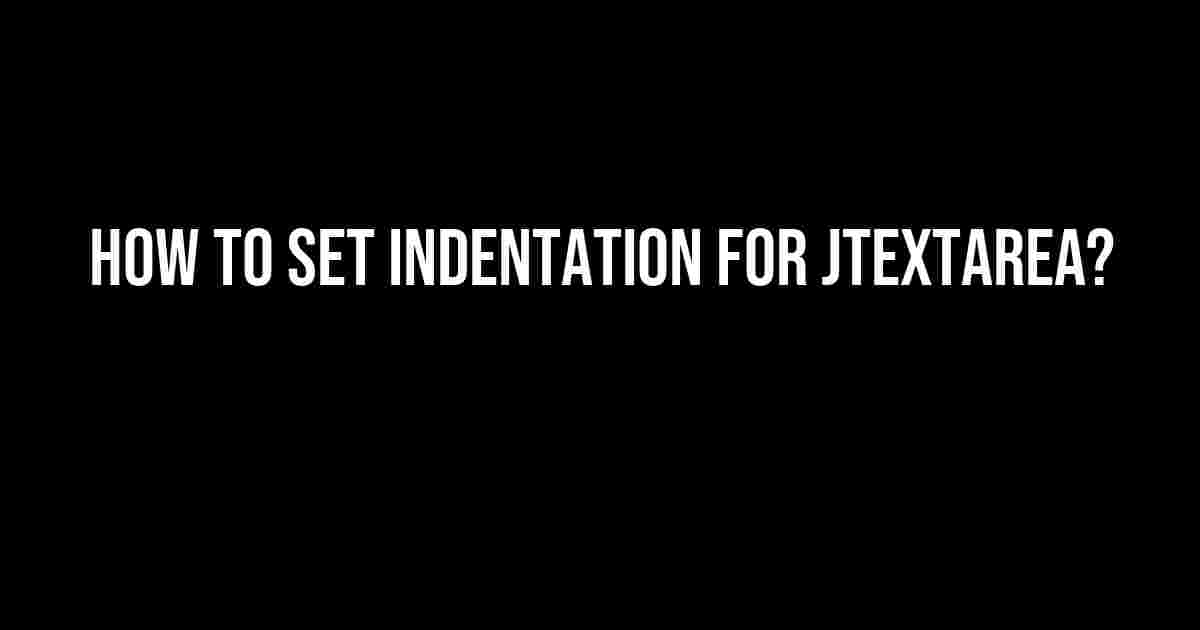When it comes to creating a user-friendly text editor, indentation is an essential feature that cannot be ignored. In Java, the JTextArea component is a popular choice for building text editors, but by default, it doesn’t support indentation. Fear not, dear developer! In this article, we’ll take you on a journey to explore the world of JTextArea indentation and provide you with a step-by-step guide on how to set it up.
Understanding JTextArea’s Default Behavior
Before we dive into the solution, let’s understand why JTextArea doesn’t support indentation out of the box. The reason lies in its default behavior. When you press the Enter key, JTextArea inserts a newline character (\n) and moves the cursor to the beginning of the next line. This behavior is dictated by the DefaultEditorKit class, which is responsible for handling the editing functionality of JTextArea.
Why Do We Need Indentation?
Indentation is an essential feature in text editors, especially when working with programming languages. It helps to:
- Improve code readability by visually separating code blocks
- Enhance code organization by grouping related statements together
- Simplify code maintenance by making it easier to identify code structures
Setting Up Indentation for JTextArea
To enable indentation in JTextArea, we need to create a custom EditorKit that overrides the default behavior. We’ll create a new class called IndentedEditorKit that will handle the indentation logic.
public class IndentedEditorKit extends DefaultEditorKit {
// ...
}
Overriding the InsertTabAction
The first step in enabling indentation is to override the InsertTabAction class, which is responsible for handling the Tab key press event. We’ll create a new class called IndentedInsertTabAction that will insert the appropriate indentation characters.
public class IndentedInsertTabAction extends InsertTabAction {
@Override
public void actionPerformed(ActionEvent e) {
JTextArea textArea = (JTextArea) getFocusedComponent();
int indentSize = 4; // adjust the indent size as needed
String indentString = String.format("%" + indentSize + "s", "");
textArea.getDocument().insertString(textArea.getCaretPosition(), indentString, null);
}
}
Overriding the InsertContentAction
The next step is to override the InsertContentAction class, which is responsible for handling the Enter key press event. We’ll create a new class called IndentedInsertContentAction that will insert the appropriate newline character and indentation characters.
public class IndentedInsertContentAction extends InsertContentAction {
@Override
public void actionPerformed(ActionEvent e) {
JTextArea textArea = (JTextArea) getFocusedComponent();
int indentSize = 4; // adjust the indent size as needed
String newline = System.getProperty("line.separator");
String indentString = String.format("%" + indentSize + "s", "");
textArea.getDocument().insertString(textArea.getCaretPosition(), newline + indentString, null);
}
}
Registering the Custom EditorKit
Now that we have our custom EditorKit classes, we need to register them with the JTextArea component.
public class IndentationExample {
public static void main(String[] args) {
JTextArea textArea = new JTextArea();
IndentedEditorKit editorKit = new IndentedEditorKit();
textArea.setEditorKit(editorKit);
// Register the custom InsertTabAction
editorKit.getAction("insert-tab").actionPerformed(new ActionEvent(textArea, 0, "insert-tab"));
// Register the custom InsertContentAction
editorKit.getAction("insert-content").actionPerformed(new ActionEvent(textArea, 0, "insert-content"));
}
}
Configuring the Indentation Settings
The final step is to configure the indentation settings to our liking. We can adjust the indent size, tab policy, and other settings to suit our needs.
public class IndentationExample {
public static void main(String[] args) {
JTextArea textArea = new JTextArea();
textArea.setTabSize(4); // adjust the tab size
textArea.setIndentSize(4); // adjust the indent size
textArea.setLineWrap(true); // enable line wrapping
textArea.setWrapStyleWord(true); // enable word wrapping
}
}
Conclusion
And there you have it! With these simple steps, you can enable indentation in JTextArea. By overriding the default behavior of the EditorKit and creating custom actions, we’ve successfully implemented indentation support in our text editor.
| Feature | Description |
|---|---|
| Indentation | Automatically inserts indentation characters when pressing the Tab key or Enter key |
| Customizable | Allows adjusting the indent size, tab size, and other settings to suit your needs |
| Extensible | Provides a foundation for further customizations and extensions |
With this implementation, you’ll be well on your way to creating a robust and user-friendly text editor that supports indentation. Happy coding!
Bonus: Advanced Indentation Techniques
For the more adventurous developers, here are some advanced indentation techniques to explore:
-
Smart Indentation: Implement a smart indentation system that adapts to the user’s coding style and language.
-
Auto-Indentation: Automatically indent the code based on the language’s syntax and conventions.
-
Code Folding: Implement code folding features that allow users to collapse and expand code blocks.
-
Syntax Highlighting: Incorporate syntax highlighting to further enhance the coding experience.
Remember, the possibilities are endless, and with a little creativity, you can create a truly exceptional text editor that rivals the best in the industry!
Frequently Asked Question
Get ready to jazz up your JTextArea with indentation! Here are the most frequently asked questions about setting indentation for JTextArea in Java.
How do I enable line wrapping in JTextArea?
To enable line wrapping in JTextArea, you can use the setLineWrap() method and set it to true. For example: `jTextArea.setLineWrap(true);`. This will allow the JTextArea to wrap lines of text to the next line when they reach the edge of the component.
How do I set the indentation size in JTextArea?
You can set the indentation size in JTextArea by using the setTabSize() method. For example: `jTextArea.setTabSize(4);`. This will set the indentation size to 4 spaces.
How do I make the JTextArea use spaces for indentation instead of tabs?
You can make the JTextArea use spaces for indentation instead of tabs by using the setIndentation() method and setting the `useTabs` parameter to false. For example: `jTextArea.setIndentation(4, false);`. This will use 4 spaces for indentation instead of tabs.
How do I set the initial indentation for JTextArea?
You can set the initial indentation for JTextArea by inserting the desired number of spaces or tabs at the beginning of the text. For example: `jTextArea.setText(” “);` will set the initial indentation to 4 spaces.
How do I preserve indentation when copying and pasting text in JTextArea?
To preserve indentation when copying and pasting text in JTextArea, you can use the getSelectedText() method to get the selected text, and then use the insertString() method to insert the text while preserving the indentation. You can also use the setContentType() method to set the content type to “text/plain” to preserve the formatting.










